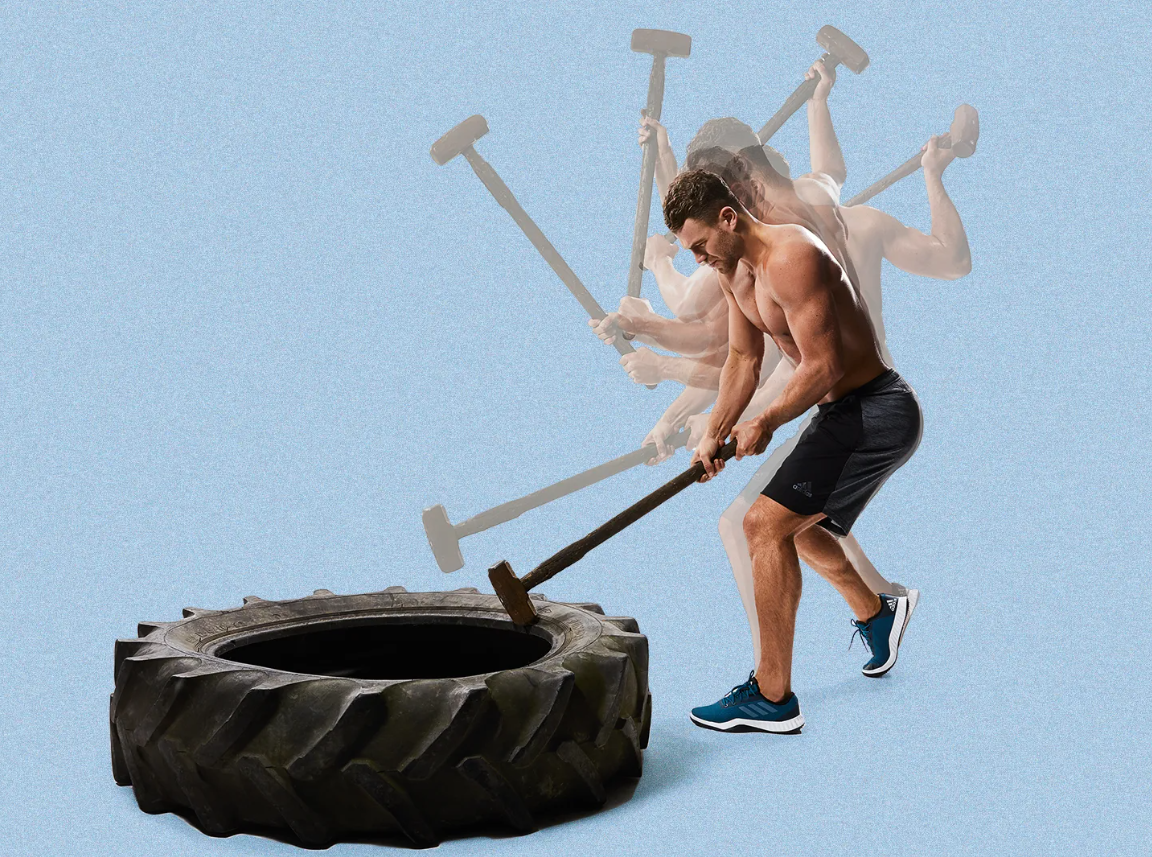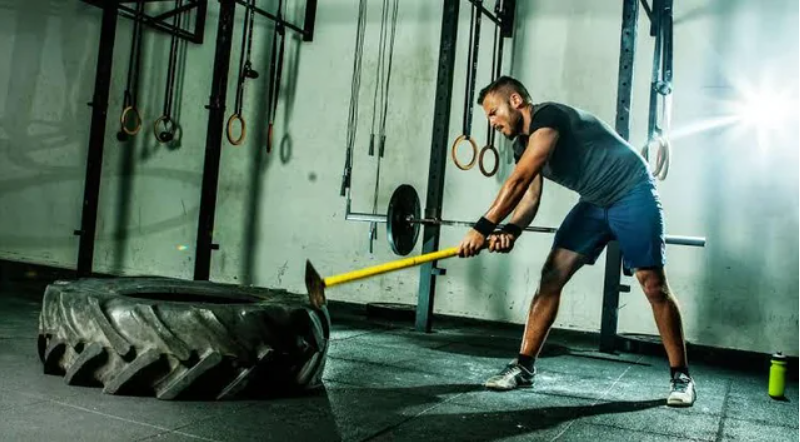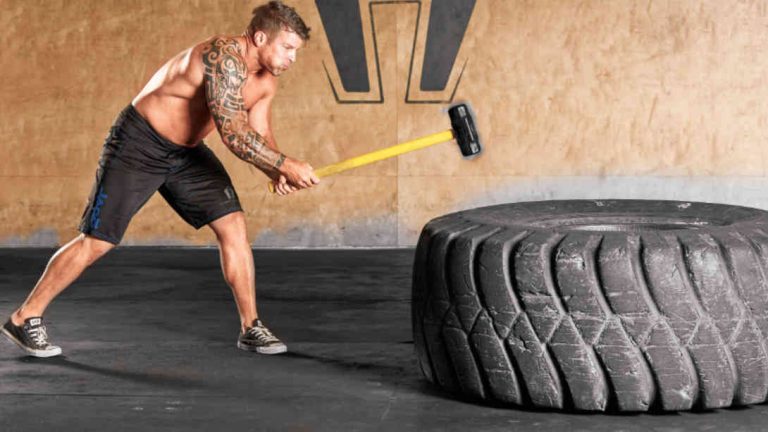In the ever-evolving landscape of fitness, sledgehammer workouts have emerged as a powerful and exhilarating training modality. These intense sessions, which involve swinging a heavy sledgehammer against a sturdy surface, offer a unique blend of cardiovascular conditioning, strength training, and functional movement. Originated from the demanding tasks of manual labourers and forged in the crucible of strength sports, sledgehammer workouts have transcended their humble beginnings to captivate fitness enthusiasts of all levels.
Benefits of Sledgehammer Training
Full-Body Conditioning
Sledgehammer workouts engage multiple muscle groups simultaneously, providing a full-body conditioning experience. The dynamic swinging motion targets the arms, shoulders, back, core, and legs, promoting overall muscular development and functional strength.
Increased Cardiovascular Endurance
The high-intensity nature of sledgehammer exercises elevates the heart rate, making them an effective cardiovascular workout. A study published in the Journal of Strength and Conditioning Research found that sledgehammer training elicited a significantly higher heart rate response compared to traditional resistance training.
Improved Grip and Core Strength
Gripping and controlling the sledgehammer requires immense forearm and grip strength, while the rotational movements and explosive swings challenge the core muscles, enhancing overall stability and power transfer.
The researchers found that incorporating sledgehammer exercises into a training program led to significant improvements in core endurance, rotational strength, and power output.
Stress Relief and Mental Toughness
The primal act of swinging a heavy sledgehammer can be a powerful stress-relieving outlet. Additionally, the intense physical and mental demands of these workouts can cultivate mental toughness and resilience.
Functional Movement Patterns
Sledgehammer exercises mimic real-world movement patterns, such as chopping, swinging, and striking, making them highly functional and applicable to various sports and activities
Safety Tips for Sledgehammer Workouts
While sledgehammer workouts offer numerous benefits, safety should be the top priority. Here are some essential safety tips:
Proper Technique
Seek guidance from a qualified instructor or trainer to learn the correct form and techniques for sledgehammer exercises.
Suitable Training Surface
Use a designated sledgehammer training area with a sturdy, shock-absorbing surface, such as tires or specialized sledgehammer mats.
Protective Gear
Wear appropriate footwear with good traction, and consider using gloves, eye protection, and other safety gear as needed.
Gradual Progression
Start with lighter sledgehammers and shorter durations, and gradually increase the weight and intensity as you build strength and endurance.
Warm-up and Cool-down
Adequately warm up before your workout and cool down afterward to prevent injuries and promote recovery.
Sledgehammer Workout Techniques when you are a beginner
Sledgehammer Swing
The sledgehammer swing is the foundational movement for most sledgehammer workouts. It involves gripping the sledgehammer with both hands, hinging at the hips, and explosively swinging the sledgehammer in front of you, engaging your core, shoulders, and back muscles.
How to do it
- Stand with feet shoulder-width apart, grip sledgehammer with both hands.
- Swing sledgehammer back between legs, then explosively up to shoulder height using hips and core.
- Allow sledgehammer to swing naturally in front, controlling descent for repeated swings.
Sledgehammer Overhead Swings
Grip the sledgehammer firmly with both hands and swing it overhead in a controlled motion. This movement focuses on developing strength in the shoulders, arms, and upper back.
How to do it
Sledgehammer Slams
Sledgehammer slams involve raising the sledgehammer overhead and forcefully slamming it down onto the training surface. This movement targets the shoulders, arms, and core while generating a powerful wave of force through the body.
How to do it
- Hold sledgehammer overhead, palms down, facing a sturdy surface.
- Forcefully slam sledgehammer down, engaging upper body and core.
- Recover quickly and repeat for a series of controlled reps to maximise muscle engagement.
Sledgehammer Circuits
Sledgehammer circuits combine various sledgehammer exercises with other functional movements, such as push-ups, burpees, or kettlebell swings, creating a high-intensity, full-body workout that challenges endurance and mental toughness.
How to do it
Warm-Up: Start with dynamic movements like arm circles and light jogging to prepare muscles.
Exercise Selection: Choose varied exercises such as swings, slams, and chops to target different muscles.
Circuit Structure: Perform exercises consecutively with minimal rest between each.
Duration and Intensity: Adjust exercise duration and sledgehammer weight based on fitness level.
Repetitions: Aim for 3-5 rounds with brief rest periods in between.
Cool Down: End with static stretches to improve flexibility and reduce muscle soreness.
How to include Sledgehammer into your Workout Routines?
Beginner Sledgehammer Workout
- Warm-up: 5-10 minutes of dynamic stretching and light cardio
- Sledgehammer Swings: 2 sets of 10-15 reps
- Sledgehammer Slams: 2 sets of 10 reps
- Sledgehammer Overhead Swings: 2 sets of 10-15 reps
- Rest: 1-2 minutes between sets
- Cool-down: 5 minutes of static stretching
Intermediate Sledgehammer Workout
- Warm-up: 10 minutes of dynamic stretching and light cardio
- Sledgehammer Swings: 3 sets of 15-20 reps
- Sledgehammer Overhead Swings: 3 sets of 10-15 reps
- Sledgehammer Slams: 3 sets of 12 reps
- Push-ups: 2 sets of 10-15 reps
- Burpees: 2 sets of 10 reps
- Rest: 1-2 minutes between sets
- Cool-down: 5 minutes of static stretching
Advanced Sledgehammer Workout
- Warm-up: 15 minutes of dynamic stretching, mobility drills, and light cardio
- Sledgehammer Swings: 4 sets of 20-25 reps
- Sledgehammer Slams: 4 sets of 15 reps
- Sledgehammer Overhead Swings: 4 sets of 15 reps
- Kettlebell Swings: 3 sets of 15-20 reps
- Plank Shoulder Taps: 3 sets of 20 reps
- Rest: 1-2 minutes between sets
- Cool-down: 10 minutes of static stretching and foam rolling
Choosing the Right Sledgehammer
Selecting the right sledgehammer weight is crucial for safety and effectiveness. Generally, beginners should start with a lighter sledgehammer, typically between 8-12 pounds, while more experienced individuals can progress to heavier weights, ranging from 16-20 pounds or even higher.
Choosing the right sledgehammer is essential to optimize your workout performance and ensure safety during exercises. Here are key considerations when selecting a sledgehammer:
1.Weight
The weight of the sledgehammer is crucial as it determines the intensity of your workout. Heavier sledgehammers provide more resistance and challenge, while lighter ones are easier to handle and more suitable for beginners.
Common weights for fitness purposes range from 4 to 12 pounds. Beginners may start with lighter weights (4-6 pounds) and gradually progress to heavier ones as strength and technique improve.
2.Handle Length
Longer handles provide greater leverage and power, making them suitable for exercises requiring more force like tire slams or overhead swings.
Shorter handles offer better control and are ideal for exercises that require precision and close-quarters work.
3.Handle Material
Sledgehammer handles are typically made of wood, fiberglass, or steel. Each material has its advantages:
Wood
Provides a traditional feel and absorbs shock well, but may be less durable.
Fiberglas
Lightweight and durable, with good shock absorption.
Steel
Very durable and resistant to damage, but heavier and transmits more shock to the hands.
Choose a handle material that suits your preference and comfort level during workouts.
4.Head Design
The head of the sledgehammer can vary in material and shape, affecting its performance:
Metal Head
Common for heavy-duty tasks, provides durability and strength.
Soft-Face Head
Includes materials like rubber or plastic, designed to protect surfaces from damage during strikes.
Dead-Blow Head
Filled with sand or shot to reduce rebound and provide a controlled impact, ideal for precision work.
Select a head design based on the type of exercises you plan to perform and the surfaces you'll be striking.
5. Grip
A comfortable and secure grip is essential for safety and effectiveness. Ensure the sledgehammer handle has adequate grip texture or consider using gloves for better handling and reduced hand fatigue.
6.Purpose and Fitness Level
Consider your fitness goals and current fitness level when choosing a sledgehammer. Beginners may benefit from lighter weights and simpler designs to focus on technique and form, while advanced users can handle heavier weights for more intense workouts.
7.Personal Preference
Ultimately, the right sledgehammer choice depends on personal preferences such as weight distribution, handle feel, and overall balance. Try different options to find the sledgehammer that feels most comfortable and effective for your workouts.
Choosing the right sledgehammer ensures you can perform exercises safely and effectively while maximizing the benefits of sledgehammer training. Whether you're aiming to build strength, improve cardiovascular fitness, or enhance functional movements, selecting the appropriate sledgehammer is key to achieving your fitness goals.
Safety Gear for Sledgehammer Training
In addition to the sledgehammer itself, it's essential to invest in proper safety gear:
Gloves: Protect your hands from calluses and blisters
Eye Protection: Safety glasses or goggles prevent debris from entering your eyes.
Footwear: Wear sturdy shoes with good traction to maintain proper footing.
Sledgehammer Mats: These specialized mats provide a shock-absorbing surface for slamming the sledgehammer.
Sledgehammer Workout Challenges
Overcoming Plateaus in Sledgehammer Workouts
As with any training program, plateaus can occur when your body adapts to the stimulus. To continue making progress, consider increasing the sledgehammer weight, incorporating more challenging variations, or adjusting your rest periods.
Mixing Up Your Sledgehammer Routine
Variety is key to avoiding boredom and ensuring continuous progress. Experiment with different sledgehammer exercises, combine them with other modalities like bodyweight training or resistance bands, and periodically change the structure of your workouts.
Sledgehammer Workout Transformation Stories
Hearing from others who have achieved remarkable transformations through sledgehammer workouts can be truly inspiring. Here are a few powerful testimonials:
Sarah, 32, Personal Trainer
"Sledgehammer training has been a game-changer for me. Not only have I gained functional strength and endurance, but it has also helped me release pent-up stress and cultivate a warrior mindset."
Ryan, 28, Fitness Enthusiast
"After years of plateau in my fitness journey, incorporating sledgehammer workouts into my routine has reignited my passion for training. The full-body conditioning and mental toughness required have taken my physique and performance to new heights."
Alisha, 33,Businesswoman and Mom
"As a busy mom, I struggled to find a workout that could be both efficient and exhilarating. Sledgehammer training has become my go-to for a high-intensity, stress-relieving sweat session. In just 30 minutes, I can get an incredible full-body workout that leaves me feeling empowered and rejuvenated. The primal nature of swinging that heavy hammer is incredibly cathartic, allowing me to release any pent-up tension or frustration from the day. Plus, the constant engagement of my core and rotational movements has really helped me regain my pre-baby strength and posture. Sledgehammer training has truly been a game-changer for me, both physically and mentally."
These inspiring stories serve as a powerful reminder of the transformative potential of sledgehammer workouts, not only for physical fitness but also for mental resilience and personal growth.
Conclusion
Sledgehammer workouts have emerged as a powerful and exhilarating training modality, capturing the attention of fitness enthusiasts worldwide. By combining full-body conditioning, cardiovascular endurance, functional movement patterns, and a primal, stress-relieving experience, these workouts offer a unique and effective way to challenge both your physical and mental limits.
Whether you're a beginner seeking a new and exciting fitness challenge or an experienced athlete looking to take your training to the next level, sledgehammer workouts can be a valuable addition to your fitness journey. By following proper safety guidelines, gradually progressing, and incorporating a variety of sledgehammer techniques and routines, you can unlock a new realm of strength, endurance, and mental fortitude.
So, embrace your inner warrior, grab that sledgehammer, and let the primal swing of this ancient tool propel you towards a stronger, more resilient version of yourself.










